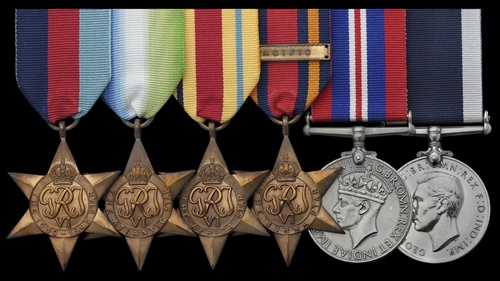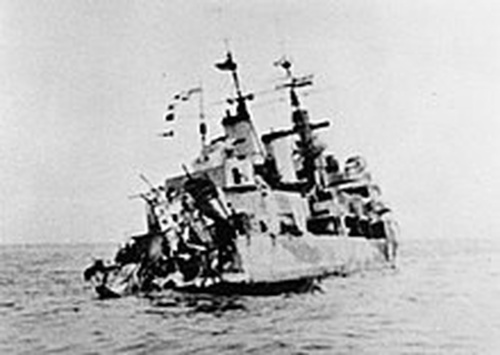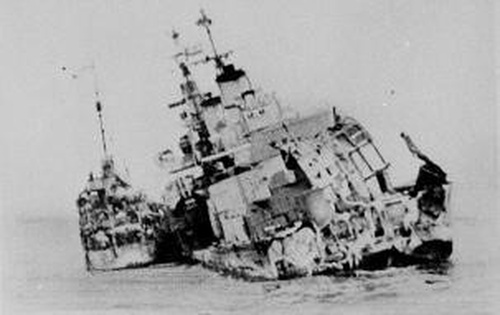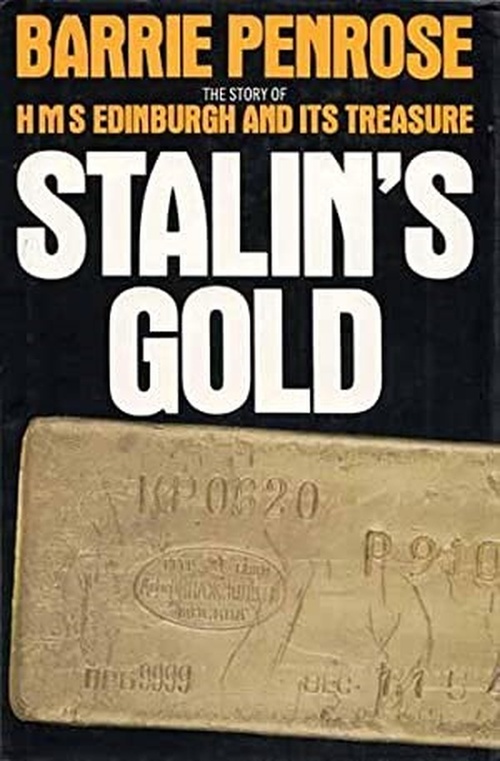Auction: 22003 - Orders, Decorations and Medals
Lot: 400
1942: 'QP' EPICS OF THE ARCTIC RUN
'Finally, Foresight was ordered to fire her one remaining torpedo. From the decks of the circling ships, officers and men watched in silence. The great ship for which they had fought and bled and for which men had died was now to be lost forever. As the lever went over the long steel torpedo carrying its lethal warhead, the final executioner of Edinburgh, leapt from the destroyer to speed on its way to the target. Those last few seconds a breathless hush of despair hung over the stretch of grey sea between the two ships. Then it was there, plunging deep into the vitals of the cruiser with a booming explosion. A sheet of flame rose high, fingering skywards, mushrooming into a pillar of black smoke. Silently at first, slowly, almost reluctantly, she rolled over on her side, then in an agony of tearing, rending metal the fore part broke away. The stern disappeared quickly but the bows rising high stayed poised for a moment, then in a tumult of bubbling, gurgling water, disappeared. With it came the smell of oil fuel. A smell they had got used to in recent days. An obscene disgusting stench that persisted, lingering on the freezing water of the Barents Sea. As Edinburgh disappeared she bore within her hull the bodies of fifty-seven men … '
The final moments of the cruiser H.M.S. Edinburgh
A Second World War campaign group of six awarded to Supply Chief Petty Officer F. M. L. Baker, Royal Navy, who survived the loss of the cruiser H.M.S. Edinburgh during QP-11 in May 1942
1939-45 Star; Atlantic Star; Africa Star; Burma Star, clasp, Pacific; War Medal 1939-45; Royal Navy L.S. & G.C., G.VI.R., 1st issue (MX. 47159 F. L. M. Baker, Sy. C.P.O., H.M.S. Valkyrie), minor official correction to rate, generally very fine or better (6)
Frank Lewis Milton Baker was born in Plympton, Devon on 13 January 1909 and entered the Royal Navy in May 1928.
By the outbreak of hostilities in September 1939, he was serving as a Petty Officer in the cruiser H.M.S. Edinburgh, and he was likewise employed at the time of her loss on the Arctic run in May 1942.
In the interim, in addition to assisting at the Lafoten raid of March 1941, Baker and his shipmates served on the Malta run, including participation in Operations "Substance" and "Halberd".
Arctic run - loss of the "Edinburgh"
From late 1941 Edinburgh served in the Icelandic Patrol and on the Arctic run and it was in this capacity - during the course of QP-11 in April-May 1942 - that she met her end, but not before miraculously surviving a double torpedo strike from the U-456; one of the torpedoes blew her stern off, wrapping her quarterdeck around X and Y turrets.
Leading Stoker Leonard Bradley takes up the story:
'Just before the torpedo struck I happened to go into the stokers' messdeck which was fairly crowded at the time and was talking to a friend of mine, a young amateur boxer called Harrington. As we chatted, the torpedo exploded in the oil tank below us. The whole messdeck split in two and as the lights went out Harrington and I and at least another 50 men fell straight through into the storage tank. The emergency lighting failed to come on and we were down there in complete darkness, floundering around in oil and water. In the blackness with men around screaming and shouting, I managed at last to get a footing and started to make my way towards where I thought the hatch might be.
As I moved, I heard Taff Harrington near me. I called out 'Taff", and he grabbed me. The oil was now pouring in fast from burst pipes in adjoining tanks and rising up to our shoulders. Harrington tried to hold my hand but it slipped and he died in the oil.
There was another boy called Harrison clinging to a stanchion. I tried to lift him above the level of the oil but he screamed blue murder for he had broken both collarbones and an ankle. All this time I was swallowing oil. Gradually the oil found its level and stopped rising. Everything went very quiet.
The hatch above us was sealed and we had no idea if the ship was afloat, partly submerged or at the bottom of the ocean. We must have been there nearly an hour when the miracle happened. The hatch was prized open and three stokers came down with ropes and pulled us to safety. Above, on the fo'c'sle deck outside the galley, Engine Room Artificer Robert Sherriff was standing talking to the Chief Cook, 'Dolly' Gray. The explosion split the deck open where they were standing and both fell through. Sherriff managed to cling to a projecting ledge and regain the deck but the Chief Cook was propelled on downward and was never seen again … '
Edinburgh was taken in tow and, as the day wore on, many acts of heroism and tragedy occurred in and around the explosion areas. Men trapped in small compartments pulled to safety in the nick of time as oil threatened to engulf them. Men caught in the blast of burst steam pipes in darkness until the flesh peeled from their bodies. Men trapped alive in unreachable compartments, a voice tube the only link with the upper deck, as officers tried to reassure them they would soon be freed knowing full well survival time was running out.
Her crew at action stations waited tense and restless, discussing the chances of reaching Murmansk before the enemy could find them. The temperature had dropped to 10 degrees below freezing. Destruction of one of the clothing stores had deprived a number of men of the clothing essential for those in exposed conditions. For these men it was sheer torture. The steady wind blowing off the Polar ice cap froze them to the marrow. With the main galley out of action it was sandwiches and cocoa for everyone. The only receptacles large enough in which to brew ship's cocoa were the officers' baths and these were immediately put into use. On lookout and open gun positions the men huddled together behind steel screens or deck lockers, trying to gain whatever warmth they could from one another. Men learned not to breathe too deeply because the shock of the cold air brought pain to the lungs. Like an insidious poison the deadly chill crept up from the feet and spread with unbelieving numbness. If a man was foolish enough to forget his gloves, a careless touch on exposed steel would peel off the flesh like paper. Eyebrows and eyelashes became white with frost. Even the tiny hairs in the nostrils became needle-sharp icicles, piercing the skin at a touch. With the contraction of metal, hatch covers jammed, door hinges and locks were frozen into immobility and gun breeches in exposed positions seized up and were useless. They had still 200 miles to cover and at the present speed of 2 knots it would be another four days and nights before they could reach the haven of Murmansk … '
It was not to be. On 2 May, off Bear Island in the Barents Sea, in the company of her consorts Foresight and Forester, she was attacked by three enemy destroyers. In the ensuing action Edinburgh severely damaged the Hermann Schoemann, causing her to be scuttled, but was herself torpedoed, suffering fatal damage. Once again, harrowing scenes ensued. Able Seaman William Wallis takes up the story:
'It was just like being in a bad car crash. All the lights went out and we were left in darkness - a blackness that defied description. Amid the deafening roar of scalding steam erupting from burst steam pipes, thick fuel oil spurted in all directions from a dozen or more fractures enveloping us in its filthy black slime. In trying to breathe we found we were swallowing the stuff. In the blackness, trying to feel our way we kept losing direction. Our one hope was to find the ladder and by clearing the lockers I eventually managed to find it. But I had a man with a broken leg hanging around my neck and as I tried to climb the ladder he was slipping from me. The ladder was also covered in oil and I couldn't get a proper grip. I managed to hold him on to me, pulling him up and out towards a glimmer of light coming from a gangway somewhere high above. I could hear them screaming down below, "Help me - help me."
By this time, my eyes were getting used to the darkness and I went down again. At the bottom of the ladder they were fighting to get up. I managed to grab one man and it turned out to be a pal of mine. Coated in the black oil however you couldn't tell one man from another. By this time I had to get out because my lungs were bursting with the smell and having swallowed some I was vomiting. After a few minutes I went down to the hatch again to see if I could do anything, only to discover that the heavy cover had fallen down with the listing and had jammed shut. I got some help but although we tried, we couldn't move it. They were still screaming when we left.
I remember hearing the hoarse cries of one man in particular. He was from our mess, a real tough guy and a bully; everybody was afraid of him, he made life a misery. He died with the rest down there …'
Unable to steer and with serious flooding, Edinburgh was abandoned and, at length, was sunk by Foresight. Her survivors - including Baker - were taken off by Foresight: two officers and 56 ratings were lost.
For further details, including the above eye-witness accounts, see:
https://www.world-war.co.uk/loss_edinburgh.php
Baker came ashore to an appointment in Drake following the loss of Edinburgh and, at the time of being awarded his L.S. & G.C. Medal in March 1943, he was serving at another shore establishment, Valkyrie at Douglas Head on the Isle of Man.
He was finally pensioned ashore in January 1957 and died in Croydon, Surrey in 1969.
Postscript: Stalin's Gold
Less well-known, owing to wartime secrecy, was the fact Edinburgh had embarked 465 gold ingots, payment for supplies delivered to the Soviet Union. Given their value - around £5 million at the time - the ingots and Edinburgh's wreck very much remained on Admiralty charts but, owing to the fact she lay some 800 feet down in the Barents Sea, early salvage attempts ended in failure.
However, all that changed in the autumn of 1981 when, amidst international publicity, Keith Jessop, an expert deep-sea diver and treasure hunter, led a successful salvage operation, raising 431 of the gold ingots, with by then an estimated value of £45 million.
Against larger competitors, he had won the contract on the basis he would not disturb the designated war grave: rather than deploy explosives and crude mechanical grabs, he used saturation divers.
At the time Jessop was so short of money that he took out a second mortgage on his home to help finance the project: had the Edinburgh recovery failed, he would have lost everything but, in the event, he received about £2 million.
Subject to 20% VAT on Buyer’s Premium. For more information please view Terms and Conditions for Buyers.
Sold for
£260
Starting price
£160











